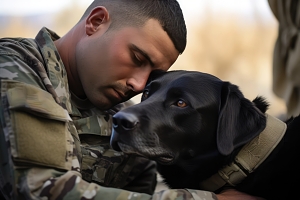Post-Traumatic Stress Disorder (PTSD) is a mental health condition that develops after exposure to a traumatic event. While it was once thought to be exclusive to humans, research and anecdotal evidence suggest that pets can also suffer from PTSD.
Animals experience emotions deeply, forming attachments to their environments and caregivers. When subjected to stress, danger, or abandonment, pets can exhibit symptoms akin to PTSD in humans.
Though the veterinary community is still developing its understanding of PTSD in animals, many professionals now recognize it as a real condition requiring diagnosis, treatment, and ongoing care. In this guide, we’ll explore the causes of PTSD in pets, how to identify its symptoms, and the best ways to support animals who have experienced trauma.
Causes of PTSD in Pets
Pets can develop PTSD due to a variety of distressing experiences. Some of the most common causes include war zone exposure, abandonment, and abuse.
War Zones: Combat Stress in Service Dogs
 Dogs have played crucial roles in military operations, working alongside soldiers in war zones as service dogs, bomb detection dogs, and search-and-rescue animals. These highly trained canines face the same dangers as their human counterparts, including exposure to gunfire, explosions, and chaotic combat environments.
Dogs have played crucial roles in military operations, working alongside soldiers in war zones as service dogs, bomb detection dogs, and search-and-rescue animals. These highly trained canines face the same dangers as their human counterparts, including exposure to gunfire, explosions, and chaotic combat environments.
While military service dogs are remarkably brave, prolonged exposure to high-stress environments can lead to PTSD-like symptoms. After returning home, these dogs may experience hypervigilance, sudden aggression, loud noise sensitivity, extreme anxiety, or avoidance behaviors. Some may even display signs of depression, losing interest in activities they once enjoyed.
The military and veterinary professionals now acknowledge PTSD in working dogs, offering rehabilitation programs, retraining, and comfort care to help these dogs adjust to civilian life. Specialized therapy can help them relearn how to respond to everyday environments with less fear and anxiety.
Abandonment: The Trauma of Being Left Behind
Dogs and cats form strong emotional bonds with their owners, and abandonment can be one of the most traumatic experiences for a pet. Whether a pet is left at a shelter, abandoned on the streets, or surrendered unexpectedly, the experience often leads to severe distress.
Pets that have been abandoned may struggle with:
- Separation Anxiety: Intense distress when left alone, leading to excessive barking, howling, or destructive behaviors.
- Fearfulness: Nervousness around new people, reluctance to leave safe spaces, or hiding for extended periods.
- Depression: Lack of interest in play, food refusal, lethargy, or withdrawal.
Shelters and rescue organizations play a crucial role in helping abandoned pets rebuild trust. Rehabilitation programs that provide structure, socialization, and positive reinforcement can help reduce their anxiety and encourage them to form new, loving bonds with adopters.
Abuse: The Lasting Effects of Mistreatment
Animal abuse, whether in the form of physical harm, neglect, or emotional abuse, leaves deep scars that impact a pet’s long-term well-being. Pets that have been mistreated often exhibit signs of PTSD, including:
- Hypervigilance: Startling easily, frequently scanning their environment for threats.
- Avoidance Behavior: Refusing to be touched, hiding, or steering clear of people or other animals.
- Aggression Due to Fear: Lunging, growling, or snapping when approached.
- Extreme Submission: Rolling onto their back, tucking their tail between their legs, or completely shutting down in response to stimuli.
Owners who adopt rescue animals with a history of abuse must practice patience, consistency, and empathy. Gentle reinforcement, structured routines, and a safe environment can help rebuild trust over time.
Recognizing Symptoms of PTSD in Pets
Every pet responds to trauma differently, but there are several key behavioral changes that may indicate PTSD. These include:
- H
 ypervigilance: Constant scanning of the surroundings and heightened alertness.
ypervigilance: Constant scanning of the surroundings and heightened alertness. - Avoidance Behaviors: Avoiding certain rooms, people, or situations that remind them of the trauma.
- Aggression or Defensive Reactions: Lashing out at humans or other animals, often due to fear or anxiety.
- Withdrawal and Depression: Becoming unusually quiet, not engaging in normal activities, and showing little interest in food or play.
- Excessive Vocalization: Excessive barking, whining, or meowing in response to stress.
- Destructive Behavior: Chewing, scratching, or digging excessively, often when left alone.
- Incontinence or Accident Issues: Unexplained urination or defecation, even if the pet was previously housetrained.
If you notice these signs in your pet, it’s important to consult a veterinarian or an animal behaviorist. A professional can evaluate your pet’s condition and recommend an appropriate treatment plan.
Treatment and Support for Pets with PTSD
Helping a pet recover from trauma requires compassion, patience, and a structured approach. Below are several key strategies that can help pets regain a sense of safety and trust.
1. Create a Safe and Calm Environment
A stable, quiet, and structured environment can help pets feel more secure. You can:
- Provide a designated safe space for your pet, such as a cozy bed or crate.
- Minimize exposure to unexpected loud noises or chaotic environments.
- Establish a consistent daily routine to help your pet feel more in control.
2. Use Positive Reinforcement
Traumatized animals respond best to positive reinforcement, using treats, praise, and gentle encouragement. Avoid punishment, as it can worsen fear-based behaviors. Reward your pet when they display calm and confident behavior.
3. Gradual Desensitization to Triggers
For pets who have specific fears (such as loud noises, strangers, or confinement), gradual desensitization can help. Expose your pet to their triggers in a controlled, low-stress manner while rewarding calm behavior. Over time, this can help reduce anxiety.
4. Behavioral Therapy with a Professional
An animal behaviorist or trainer can provide personalized training and therapy techniques to address PTSD-related behaviors. Specialized programs may involve counter-conditioning and trust-building exercises.
5. Medication and Veterinary Support
Some pets may benefit from veterinary-prescribed anti-anxiety medications or supplements. These medications do not “cure” PTSD but can help lessen its symptoms, making behavioral therapy more effective. Discuss your options with a veterinarian.
6. Provide Mental and Physical Stimulation
Enrichment activities help reduce stress and promote positive engagement. Activities include:
- Interactive toys and puzzle feeders
- Regular exercise and outdoor playtime
- Socialization with trusted animals and people
Empathy and Patience: The Keys to Recovery
 Recovering from PTSD is a slow process for pets, but with empathy and patient care, they can regain their confidence and trust. Rehabilitation requires long-term commitment, but the reward of watching a traumatized pet heal is invaluable.
Recovering from PTSD is a slow process for pets, but with empathy and patient care, they can regain their confidence and trust. Rehabilitation requires long-term commitment, but the reward of watching a traumatized pet heal is invaluable.
If you’ve recently adopted a rescue pet or your longtime companion is showing signs of trauma-related stress, don’t hesitate to seek professional help.
Let Paw Pals Help with Pet Care
At Paw Pals Pet Sitting, we understand the challenges of caring for pets who have experienced trauma. A compassionate, professional pet sitter can provide a sense of security and routine while you’re away, ensuring your beloved pet feels comfortable and cared for.
If your pet needs extra attention, patience, and support, our experienced pet sitters are here to help. Contact Paw Pals today to learn how our pet care services can benefit your furry family member. Together, we can provide the love, structure, and reassurance pets need to thrive.


